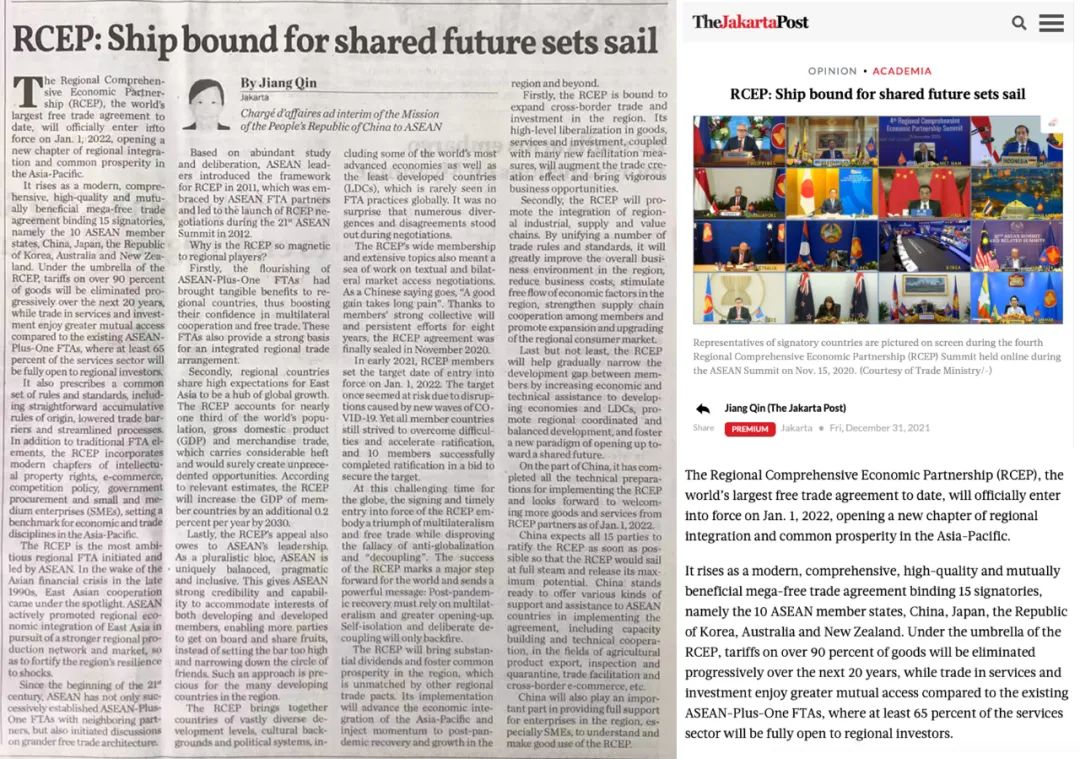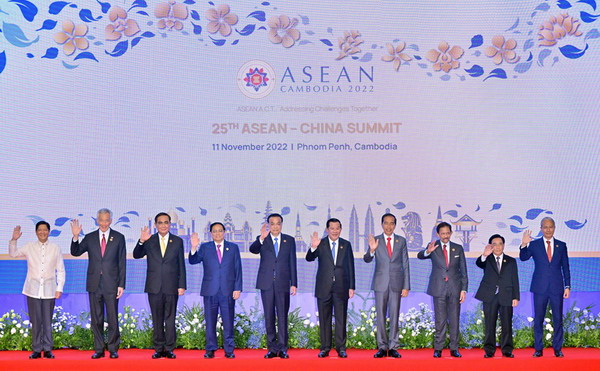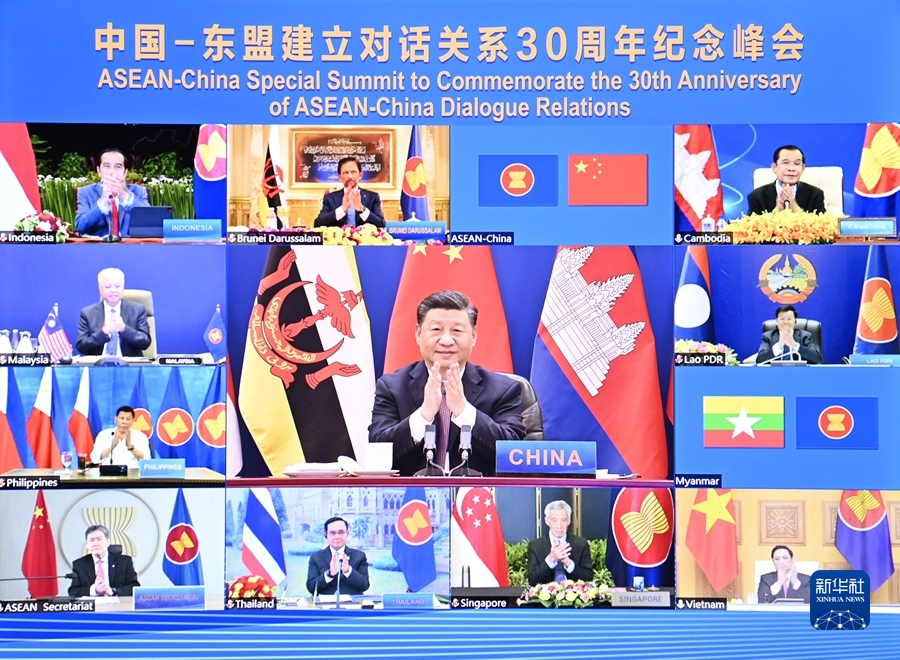
The Regional Comprehensive Economic Partnership (RCEP), the world’s largest free trade agreement to date, officially enters into force on January 1, 2022, opening a new chapter of regional integration and common prosperity in the Asia-Pacific.
It rises as a modern, comprehensive, high-quality and mutually-beneficial mega-FTA bonding 15 signatories, namely the ten ASEAN Member States, China, Japan, the Republic of Korea, Australia and New Zealand. Under the umbrella of RCEP, tariffs on over 90 percent of goods will be eliminated progressively over the next 20 years, while trade in services and investment enjoy greater mutual access compared to the existing ASEAN-Plus-One FTAs, where at least 65 percent of the services sectors will be fully open to regional investors.
It also prescribes a common set of rules and standards, including straightforward accumulative rules of origin, lowered trade barriers and streamlined processes. In addition to traditional FTA elements, RCEP incorporates modern chapters of intellectual property rights, e-commerce, competition policy, government procurement and small and medium-sized enterprises (SMEs), setting a benchmark for economic and trade disciplines in the Asia-Pacific.
An ambitious and magnetic architecture for Asia-Pacific economic integration
RCEP is the most ambitious regional FTA initiated and led by ASEAN. In the wake of the Asian financial crisis in late 1990s, East Asian cooperation came under the spotlight. ASEAN actively promoted regional economic integration of East Asia in pursuit of a stronger regional production network and market, so as to fortify the region’s resilience to shocks.
Since the beginning of the 21st century, ASEAN has not only successively established ASEAN-Plus-One FTAs with neighboring partners, but also initiated discussions on grander free trade architecture.
Based on abundant study and deliberation, ASEAN leaders introduced the framework for RCEP in 2011, which was embraced by ASEAN FTA partners and led to the launch of RCEP negotiations during the 21st ASEAN Summit in 2012.
Why is RCEP so magnetic to regional players?
Firstly, the flourishing of ASEAN-Plus-One FTAs had brought tangible benefits to regional countries, thus boosting their confidence in multilateral cooperation and free trade. These FTAs also provide a strong basis for an integrated regional trade arrangement.
Secondly, regional countries share high expectations for East Asia to be a hub of global growth. RCEP accounts for nearly one third of the world’s population, GDP and merchandise trade, which carries considerable heft and would surely create unprecedented opportunities. According to relevant estimates, RCEP will increase the GDP of member countries by an additional 0.2 percent per year by 2030.
Lastly, RCEP’s appeal also owes to ASEAN’s leadership. As a pluralistic bloc, ASEAN is uniquely balanced, pragmatic and inclusive. This gives ASEAN strong credibility and capability to accommodate interests of both developing and developed members, enabling more parties to get on board and share fruits, instead of setting the bar too high and narrowing down circle of friends. Such approach is precious for the many developing countries in the region.
Against all odds, multilateralism and free trade win
RCEP brings together countries of vastly diverse development levels, cultural backgrounds and political systems, including some of the world’s most advanced economies as well as the least developed countries (LDCs), which is rarely seen in FTA practices globally. It was no surprise that numerous divergences and disagreements stood out during negotiations.
RCEP’s wide membership and extensive topics also meant a sea of work on textual and bilateral market access negotiations. As a Chinese saying goes, “A good gain takes long pain”. Thanks to members’ strong collective will and persistent efforts for eight years long, the RCEP agreement was finally sealed in November 2020.
In early 2021, RCEP members set the target date of entry into force on January 1, 2022. The target once seemed at risk due to disruptions caused by new waves of COVID-19. Yet all member countries still strived to overcome difficulties and accelerate ratification, and 10 members successfully completed ratification in a bid to secure the target.
At this challenging time for the globe, the signing and timely entry into force of RCEP embody a triumph of multilateralism and free trade while disproving the fallacy of anti-globalization and “decoupling”. The success of RCEP marks a major step forward for the world and sends a powerful message: post-pandemic recovery must rely on multilateralism and greater opening-up. Self-isolation and deliberate decoupling will only backfire.
Towards the shared future of common prosperity
RCEP will bring substantial dividends and foster common prosperity in the region, which is unmatched by other regional trade pacts. Its implementation will advance the economic integration of the Asia-Pacific and inject momentum to post-pandemic recovery and growth in the region and beyond.
Firstly, RCEP is bound to expand cross-border trade and investment in the region. Its high-level liberalization in goods, services and investment, coupled with many new facilitation measures, will augment trade creation effect and bring vigorous business opportunities.
Secondly, RCEP will promote the integration of regional industrial, supply and value chains. By unifying a number of trade rules and standards, it will greatly improve the overall business environment in the region, reduce business costs, stimulate free flow of economic factors in the region, strengthen supply chain cooperation among members and promote expansion and upgrading of the regional consumer market.
Last but not least, RCEP will help gradually narrow the development gap between members by increasing economic and technical assistance to developing economies and LDCs, promote regional coordinated and balanced development, and foster a new paradigm of opening up towards a shared future.
On the part of China, it has completed all the technical preparations for implementing RCEP and looks forward to welcoming more goods and services from RCEP partners as of January 1, 2022.
China expects all 15 parties to ratify RCEP as soon as possible so that the RCEP would sail at full steam and release its maximum potential. China stands ready to offer various kinds of support and assistance to ASEAN countries in implementing the agreement, including capacity building and technical cooperation, in the fields of agricultural product export, inspection and quarantine, trade facilitation and cross-border e-commerce, etc.
China will also play an important part in providing full support for enterprises in the region, especially SMEs, to understand and make good use of RCEP.











